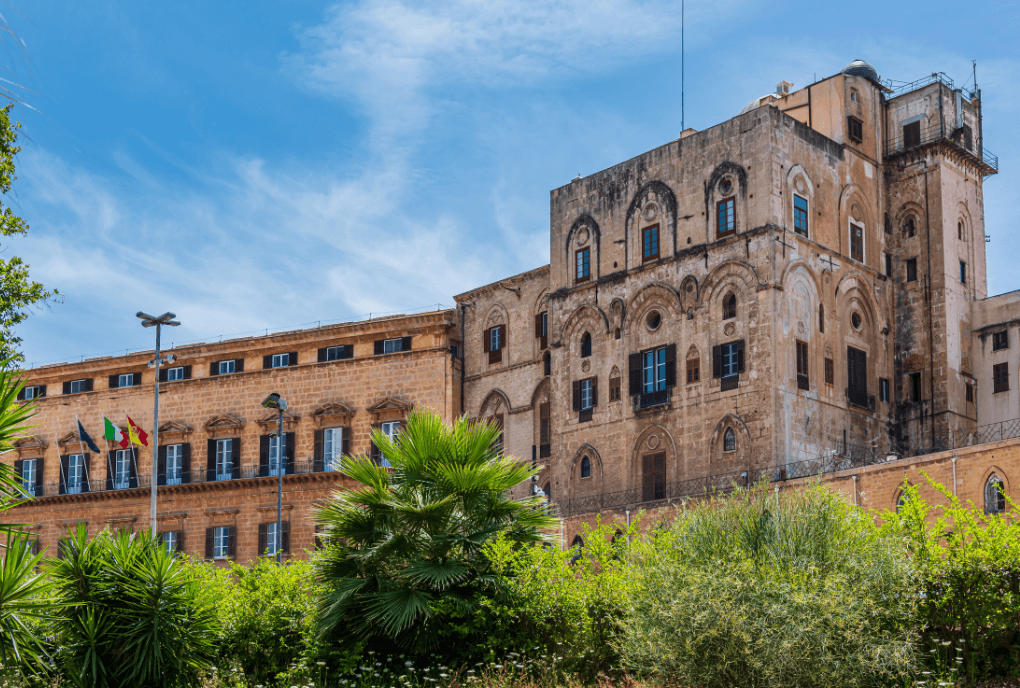
Palace of the Normans: the oldest residence in Europe
The palace is the heart of the Arab-Norman itinerary in Sicily and is a testament to wealth, political power and various cultural influences.
The Norman Palace in Palermo is Europe’s oldest royal residence. It was home to the Kingdom of Sicily, later, the imperial seat of Frederick II and Conrad IV and the historic Sicilian Parliament. Its history of intermingling and continuous layering reflects the Norman cosmopolitanism, accompanied by many arts and diversity, which can still be seen today in the Palatine Chapel, where Byzantine, Latin Islamic elements coexist together.
The history of the Palace
The palace, also known as the Royal Palace, is now one of the most visited destinations in Sicily. Its history is long and tangled. Layers of early fortified settlements, dating from the 8th and 5th centuries B.C. of Punic origin, emerge in the foundations of the present building.
There are traces of Greeks and Romans who in 254 B.C., conquered the stronghold. The building achieved palace status with the conquest of the fortification by the Arabs, who imposed their rule for about three centuries, thus occupying Sicily and turning Palermo into their capital.
It was the Arabs who built the Qasr (home of the emirs) with the reputation of being the first building with functions of a royal residence.
Later, in 1132, there was the Norman conquest under Roger II of Sicily, who built what today bears the name Roger Hall, the Palatine Chapel and the Joharia Tower. During the reign of William I and William II, the building underwent several additions and alterations. It was in these environments that the most important European culture of the time developed. Emperors would gather the greatest scientists and artists of the time here.
The Palace of the Normans under the reign of Frederick II
The period of splendor continued with the reign of Frederick I of Swabia. Under his leadership, the court played a leading cultural role in Italy and Europe. Government, administrative and chancery activities were kept in the palace, while literary activities were detached to the Palace of Favara, which became the seat of the Sicilian poetic school.
After several centuries of neglect and decay, during the Sicilian Vespers uprisings that culminated in 1282, the Norman Palace became the residence of the Spanish viceroys in 1555. Thus it was that the military structures were demolished to make way for porticoed inner courtyards. In 1616 the facade was renovated in the Renaissance style. During the Spanish period, there were many additions and architectural changes to the palace that followed.
From the 1700s to the present
In the 18th century, under Bourbon rule, there were several renovations and improvements. Especially of all the royal apartments and internal structures of the complex, while in the 19th century the exteriors were restored in the Arab-Norman style, with results still visible today.
After the Unification of Italy, the Royal Palace became the seat of several academies, and in 1921, the property was purchased by the government. After the end of World War II, the first archaeological assays began to understand the various historical layers of the building. In 1947, the Palace became the seat of the Sicilian Regional Assembly and was named Palazzo dei Normanni.
The fortress became one of the UNESCO sites in 2015 and became a World Heritage Site. To date, tourism services are taken care of by the Frederick II Foundation. Today it is the seat of the Sicilian Regional Assembly.
The Palatine Chapel
A treasure of rare beauty in the palace is surely the Palatine Chapel, which was erected by Roger II after his coronation. Architecturally, the Palatine Chapel represents the meeting of different cultures and religions, suggesting in Palermo’s complex history. Indeed, its construction involved Byzantine, Islamic and Latin craftsmen.
The church was dedicated to St. Peter the Apostle and has a floor plan in which the harmonious coexistence of Latin and Byzantine elements is visible. Rich in mosaics, among the most important in Sicily, the oldest that can be admired is in the presbytery and depicts scenes from the New Testament, including the baptism of Christ, a work of great stylistic refinement.
Royal Apartments
The royal apartments of the Palace of the Normans are built from 11 different rooms, including the Pompeian Room, the Viceroy Room, the Chinese Room, and the Hercules Room.
The Pompeian Hall is part of the so-called Pompeian Gallery commissioned by Leopold of Bourbon. It was decorated by Giuseppe Patania in the neoclassical style with mythological representations inspired by the archaeological discovery of Herculaneum and Pompeii.
The fashion present between the 18th and 19th centuries in royal courts can be seen in the Chinese Hall. Paintings of men and women wearing Chinese-style clothes and having oriental-like facial features emerge against the blue background.
The name of the Viceroys’ Room comes from the 21 portraits posted on its walls depicting the viceroys, presidents, and lieutenants of the Bourbon kingdom of Sicily.
The Hall of Hercules gets its name from the painting inside, completed in the 19th century by Velasquez, which depicts the cycle dedicated to the Greek mythological hero.
What to see at the Palace of the Normans
The entrance to the Palace is located in Parliament Square, and the sightseeing tour includes a visit to the Palatine Chapel, all rooms of the Royal Apartments and Gardens.
To visit the building you can purchase the online ticket on the official website of the Frederick II Foundation, which also allows you to visit the current exhibition.
The palace is open Monday through Saturday from 8:30 a.m. to 4:30 p.m. and Sundays and holidays from 8:30 a.m. to 12:30 p.m.
Giulia Nari





